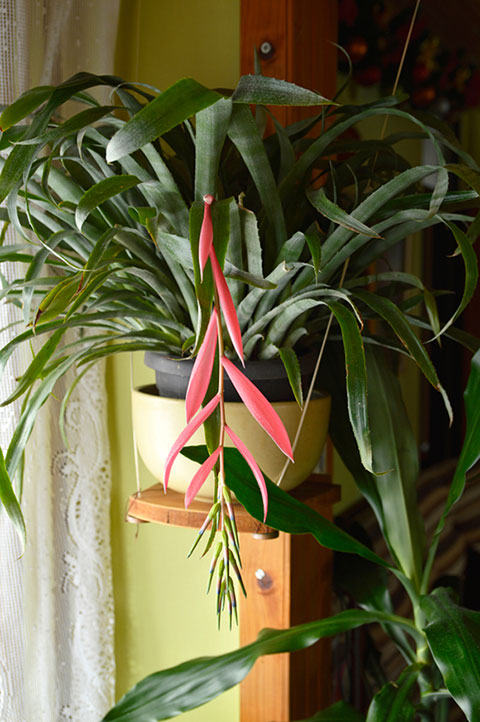The Bilbergia Nutans or Queen’s Tears is a stunning array of colors. The bromeliad has thick outward arching leaves that reach a length of about 15 inches. The plant produces stems with bright pink bracts and green petaled flowers that are trimmed in blue with long yellow stamens. The plant goes by the nickname of the friendship plant because its offsets grow easily for frequent gift-giving.
Temperature and Humidity
The Queen’s Tears is a tropical plant and native to Argentina, Uruguay, and Brazil, so it does best in warm, humid conditions. The plant prefers air temperatures around 60-75 degrees during winter and slightly warmer in the summer, and 40-50 percent humidity. Dry air will cause the tips on the leaves to turn brown.
Watering and Misting
The plant is relatively drought tolerant because it collects moisture from the air. The plant thrives when watered daily during the summer, but it should only receive enough water to keep the soil moist. Mist the leaves daily as well to prevent the tips from browning and mist any upward flower cups to allow them to retain some water for the plant to use as needed. During the rest of the year, add only enough water to keep the soil slightly damp and mist every few days.
Tap water may leave spots on the leaves if it contains chlorine and fluoride. Plant owners on municipal water systems may want to use only rainwater or filtered water for their plants.
Light and Soil
Partial shade protects the flowers and leaves during the summer. Aim for bright, indirect sunlight the remainder of the year. The Queen’s Tears grows best in an orchid soil mixture, but it is possible to simulate this mix if orchid soil is not available. Combine two parts tree bark mixture to one-part gardening soil instead.
Repotting and Propagating
Repot the plant as needed. A plant pot five inches across is typically the largest the plant will need. Only repot plants before flowering occurs, which typically happens in early to mid-spring. Wait until after flowering ends before propagating.
Trim new shoots from the base of the plant once they are at least six inches in length. The shoots go immediately into potting soil. It usually takes a couple of weeks for the new shoots to establish roots. Water the new growth the same as a mature plant.

Fertilizer and Insecticide
Fertilize the plant in the spring and summer with diluted liquid fertilizer. Mix the liquid in a half-and-half mixture with water and use it to water the plant as normal. Do the same during the fall and winter but only fertilize once a month. Mist the same mixture over the leaves at the same time.
Plants occasionally left outside can become a target for garden pests. Wipe the leaves with rubbing alcohol, and then water to remove mealybugs. Insecticidal soaps can also help to remove many pests but rinse off the soap after application. The risk of infestation is almost non-existent if the plant stays inside.




